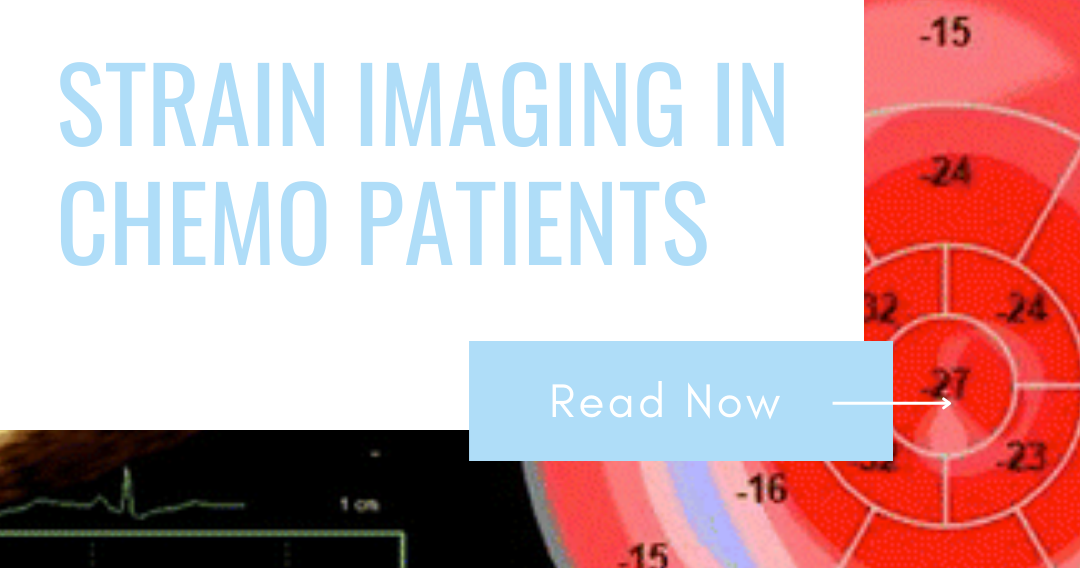Strain Imaging In Chemo Patients

Strain imaging or “speckle-tracking echo” is an advanced imaging technique that NWCD is proud to be a leader in. This technique is used to assess the deformation of the myocardium (heart muscle). By following “speckles,” or natural acoustic markers within the myocardium, we are able to assess the degree and rate of deformation of the heart fibres. Strain parameters typically include the length of the heart muscle, the circumferential strain (or measurement around the heart), as well as the thickness of the muscle.
Strain imaging in echocardiography is a valuable tool for early detection of cardiomyopathies, ischemic heart disease, and cardiotoxicity – a significant benefit for chemotherapy patients. Cancer treatments including chemotherapy and radiation can put patients at a high risk for a variety of cardiovascular conditions. The second leading cause of mortality in cancer survivors is cardiovascular disease (heart failure, coronary artery disease, peripheral vascular disease, thromboembolism, pericarditis, valvular disease, arrhythmias, hypertension & stroke). Different therapies have a variety of complications which are also affected by outside factors. These factors include the patients age, cardiac history and genetic pattern. CTRCDs (cancer-therapy-related cardiac dysfunctions) may present immediately or many years after treatment.
The quickest tool in detecting CTRCDs is an echocardiogram. Strain imaging has become an essential tool for early detection as it is more sensitive and can indicate reduced left ventricular ejection fraction (LVEF) before the patient becomes symptomatic. Global Strain analysis can detect small changes in the heart function. This provides a more accurate assessment of cardiac health before, during, and after treatment.
Early detection of decreased LVEF or heart function is crucial in improving the quality of life for cancer patients by ensuring the most effective treatment is used with the lowest cardiac risk factors. It also provides care providers the time to mitigate less successful treatments before permanent damage ensues.
Often before starting a treatment plan, a patient will undergo a baseline echo in which all future reports are compared, thus ensuring the heart function remains stable. Continuous monitoring is essential in improving patient outcomes. If any decline is detected, oncologists can modify the treatment plan or provide supplemental treatment of beta-blockers or ACE inhibitors.
Every patient is unique in the treatment plans set out for them by their oncologists however it is very common during treatment to see a patient receive an echo every 3 months. If a patient develops any symptoms during treatment their physician can send them even more frequently. As chemo and radiation lessens, it is likely a patient will only need to come in every 6 months, then as a yearly follow up.
Echocardiograms are the leading method in which strain imaging and cardiotoxicity are monitored in chemo patients. This is largely due to the availability of the exam, as well as its non invasive techniques and lack of additional radiation for the patients. By monitoring chemo patients closely, the goal is to support anti cancer therapy while increasing their quality of life. In this care, NWCD is second to none.
“Myocardial Strain Measured by Speckle-Tracking Echo.”
American College of Cardiology,
https://www.acc.org/Latest-in-Cardiology/ten-points-to-remember/2017/02/23/13/20/
http%3a%2f%2fwww.acc.org%2fLatest-in-Cardiology%2ften-points-to-remember
%2f2017%2f02%2f23%2f13%2f20%2fA-Test-in-Context-Myocardial-Strain-Measured. Accessed 2 July 2024.
Ntoskas, Theodoros.
“Cardio-Oncology: The Role of Echocardiography in Cancer Patients.”
Advanced Concepts in Endocarditis - 2021, IntechOpen, 2020.
www.intechopen.com, https://doi.org/10.5772/intechopen.93085.
Fabiani, Iacopo, et al.
“Speckle-Tracking Imaging, Principles and Clinical Applications:
A Review for Clinical Cardiologists.”
Echocardiography in Heart Failure and Cardiac Electrophysiology,
IntechOpen, 2016. www.intechopen.com, https://doi.org/10.5772/64261.
